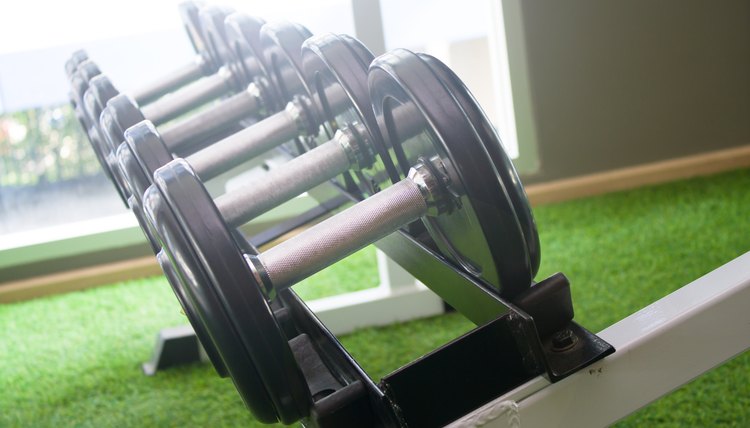The History of Exercise Equipment

The history of fitness goes back to early man's need for physical strength and speed while hunting. As the centuries carried on and individual cultures developed, human beings became more sedentary. This lead to an interest in fitness not as a necessity of survival, but as an important aspect of a long, healthy life. Fitness equipment has been key to this change, helping generations of people from around the world shape and condition their bodies.
Free Weights
Although body-weight, calisthenic and yoga-based exercises were practiced by the ancient Eygptians, Chinese, Indians and other cultures, the ancient Greeks are credited with developing the earliest forms of modern weight training equipment. One of the first "free weights" used in athletic training were halteres, or hand-held weights with a hole for gripping rather than a handle. Halteres were used as early as the fifth century B.C. and were used to develop muscular strength and for training for sports like the long jump. Illustrations of early Greece show muscular men using dumbbells, weight plates and plummets to train for physical strength.
Resistance Machines
After the development of free weights, it took hundreds of years for a major advancement in resistance training to occur. In the 1950s, American fitness guru Jack LaLanne innovated several pieces of equipment that have been widely used ever since. LaLanne developed the first cable-pulley machine, the Smith machine and the first leg extensions machine. The mechanical principals behind these three pieces of equipment can be found in equipment in gyms around the world.
Cardiovascular Equipment
The most popular piece of cardiovascular exercise equipment, the treadmill, was first introduced in 1875, but it wasn't used for exercise, it was used for manufacturing. In 1952, University of Washington in Seattle doctor Robert A. Bruce began using treadmills for human stress tests. This inspired businessmen to turn the treadmill into a consumer exercise device that would allow someone to run or jog naturally while staying in place. By the 1960s, treadmills were common in homes and gyms. Elliptical machines, which are similar in function to treadmills but place less stress on the lower body, were first released in the mid-1990s and have rivaled treadmills in popularity ever since.
Resistance Bands
Resistance bands, which are essentially strips of elastic that create progressive resistance as they are stretched, were first used by former football coach Dick Hartzell for functional training in 1980. Since then, manufactures have modified resistance bands by attaching handles and creating anchors that allow resistance bands to mimic almost any gym exercise that can be performed with free weights, but without the bulk, making them much more portable than free weights.
New Innovations
Technological advancements over the past 30 years have helped introduced dozens of pieces of exercises equipment that weren't possible before. Home gyms like Bowflex have replaced weight plates with polymer rods that create tension as they bend. Bowflex and other manufactures have developed dumbbells that can automatically change weight through a dial system. There are many pieces of innovative cardiovascular equipment now on the market, including step climbers, climbing machines, and treadmills with two independent walking surfaces for each foot.
References
Writer Bio
Kip Doyle, the managing editor at a weekly newspaper in Western New York, has over 12 years of experience researching and participating in sports and physical fitness. Doyle, who also writes about technology, music and pop culture, has been published by several newspapers, as well as websites like Punknews.org.
